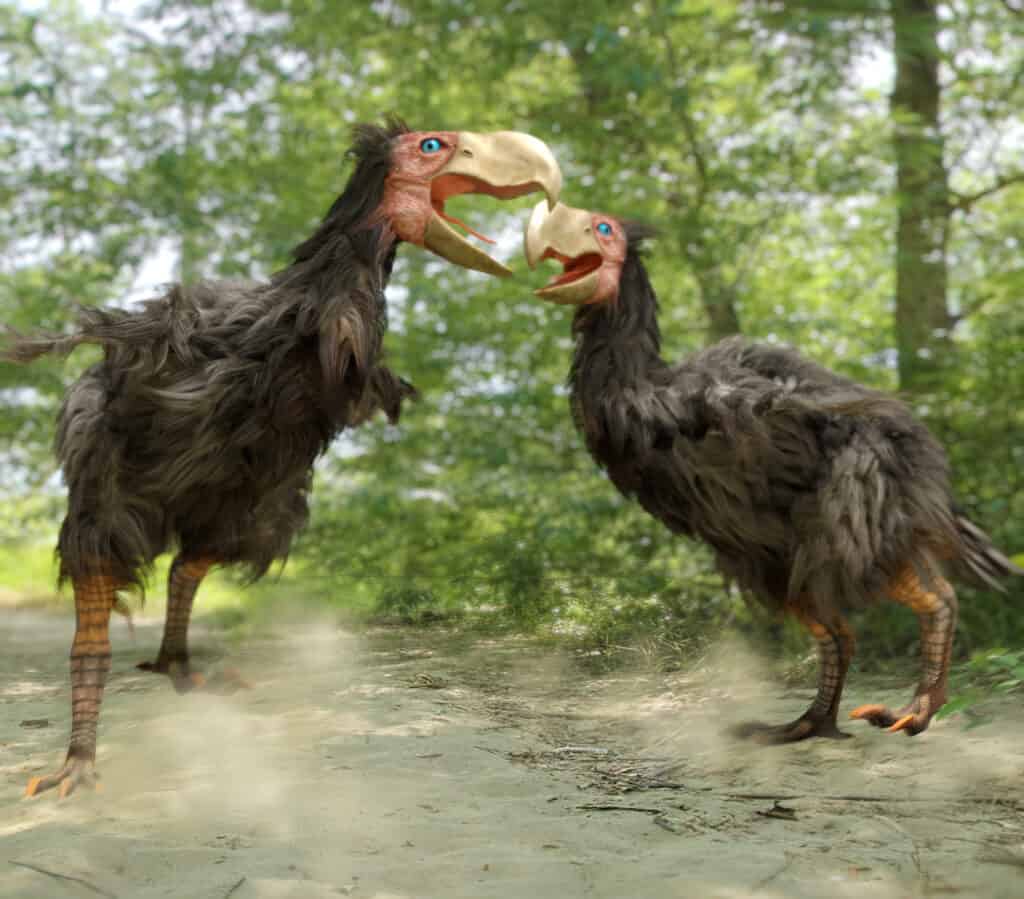Gastornis
Gastornis parisiensis
Gastornis had a massive beak, but they probably ate plants instead of flesh.
Advertisement
Gastornis Scientific Classification
- Kingdom
- Animalia
- Phylum
- Chordata
- Class
- Aves
- Order
- Gastornithiformes
- Family
- Gastornithidae
- Genus
- Gastornis
- Scientific Name
- Gastornis parisiensis
Read our Complete Guide to Classification of Animals.
Gastornis Conservation Status
Gastornis Facts
- Fun Fact
- Gastornis had a massive beak, but they probably ate plants instead of flesh.
- Biggest Threat
- Carnivorous mammals
- Most Distinctive Feature
- Massive head with enormous beak
- Distinctive Feature
- Long powerful legs
- Habitat
- Dense forests with a moist to dry tropical or subtropical climate
- Diet
- Herbivore
- Favorite Food
- Tough plants and seeds
- Type
- Large, extinct flightless bird
- Special Features
- massive beaks with no raptorial curve
- Number Of Species
- 6
Gastornis Physical Characteristics
- Skin Type
- Feathers
- Weight
- 300–340 pounds
- Height
- 6 feet 7 inches
- Venomous
- No
- Aggression
- Low
View all of the Gastornis images!
Gastornis is a genus of large flightless birds alive in the Mid-Paleocene to Mid-Eocene epochs of the Paleogene period. It was formerly known as Diatryma. Gastornis were giant birds with huge beaks that gave them a menacing appearance. However, contrary to expectations, this massive bird was most likely a herbivore instead of a carnivore.
Description and Size

Gastornis was a six feet tall bird and weighed a few hundred pounds.
©Aunt Spray/Shutterstock.com
Gastornis is a genus of large flightless birds that lived between 55 and 40 million years ago during the Paleogene period. Fossils of this giant bird have been found in various locations across Europe, Asia, and North America. The genus was named after Gaston Planté, the young man who discovered the first fossil of the bird.
Gastornis was a six feet tall bird and weighed a few hundred pounds. About six species of this bird have been identified so far. The largest of these is the Gastornis gigantea, whose size is often compared to the predatory terror birds (phorusrhacids) of South America and the moa of New Zealand. The G. gigantea reached heights of up to 6 feet 7 inches and weighed between 300 and 340 pounds.
The Gastornis had well-developed legs but underdeveloped wings. Their wings and body feathers were mainly for insulation rather than flight. This giant flightless bird had a relatively huge skull compared to the rest of its body. It had small nostrils close to the eye midway up to the skull.
Their neck had at least 13 massive vertebrae but was still relatively short because vertebrae were short and bulky. It had large feet with very small talons, uncharacteristic of carnivorous birds.
Diet—What Did the Gastornis Eat?
Gastornis looked a lot like the South American terror birds, and scientists once thought of it as an apex predator of its time. However, recent research suggests it was more likely to be a herbivore that fed on tough plant materials and seeds.
One piece of evidence against the carnivore argument was the absence of a raptorial hook on the beak of the Gastornis. This curved hook is a common feature of the beak of predatory birds. The Gastornis‘ feet also lacked the curved talons to hook and tear into prey. The legs were large, and this would have made the bird too slow to catch fast-moving prey. If this bird ate flesh at all, it was either an ambush hunter or a scavenger. Alternatively, they hunted as packs to take down predators. But these theories seem unlikely because this bird was too poorly-equipped to be an apex predator.
Recently, scientists also examined the composition of the bird’s bones to determine the calcium isotope composition. From this study, it became apparent that the bird most likely derived its food from plants rather than animal tissue, as earlier speculated.
Habitat—When and Where Did the Gastornis Live
Gastornis lived during the Paleogene period (between the mid-Paleocene to mid-Eocene epochs). This was about 55 to 40 million years ago. Fossils of this giant bird have been found across different continents, including Asia, Europe, and North America. This shows it had a fairly widespread distribution. Gastornis lived in dense forests with a moist to dry tropical or subtropical climate. Scientists think it also inhabited woodlands.
Threats and Predators
Whether or not this bird was preyed on by bigger animals that lived in the Paleogene is unknown. But it is believed that their fearsome look and massive size would have scared off predators. Gastornis‘ main threats were changing climatic conditions and natural disasters. Gastornis were among the largest alive during the Paleogene. However, as the period progressed into the Mid-Eocene, large mammalian predators like the mesonychids and creodonts started to rise across North America and Eurasia. Their rise would have been a major threat to the giant birds.
Discoveries and Fossils—Where Was Gastornis Found?
The first Gastornis fossil was found in the Argile Plastique Formation near Paris by Gaston Plante in 1855. The genus is named after the young man that discovered it, while the specific name parisiennes refers to the city of Paris. It was a notable discovery not just because of its large size but also because it was one of the oldest known birds.
More fossils of this massive bird were found in the 1860s and 1870s. The fossils found in the late 19th century were fragmented, leading to an inaccurate description. In 1916, the first complete skeleton (including the skull) was discovered in the Wildwood Formation in Wyoming. This all-important discovery made it easier to get a clear picture of what this bird looked like.
Extinction—When Did the Gastornis Die Out
Gastornis went extinct in the mid to late Eocene of the Paleogene Period. The exact reason for their disappearance is unknown, but scientists think the rise of mammalian predators might have contributed to their decline. The extinction of this giant bird coincides with the appearance of mammalian predators like the large creodont and mesonychids during the Mid-Eocene Epoch.
Similar Animals to the Gastornis
Similar animals to the Gastornis include:
- Phorusrhacidae — More commonly known as terror birds, this was a group of giant flightless birds that lived in South America during the Cenozoic Era. Like the Gastornis, terror birds could not, but both species are unrelated.
- Moa — This is an extinct genus of flightless birds native to New Zealand. Although they varied in size, the largest species were up to 12 feet tall.
- Anseriformes — Scientists think the Gastornis is more closely related to waterfowls (order Anseriformes). There are more than 180 living species of birds in this family. Most species in this family show various adaptations to an aquatic habitat.
Related Animals
View all 170 animals that start with GGastornis FAQs (Frequently Asked Questions)
When was Gastornis alive?
Gastornis lived about 55 to 40 million years ago between the Late Paleocene and Eocene periods. Their population declined during the mid-Eocene epoch, eventually dying off.
How big was Gastornis?
Gastornis was one of the largest birds of their time. It was more than six feet tall and weighed about 376 pounds. This means the Gastornis was tall enough to look a person in the eye, and some were even taller than humans.
Is Gastornis a terror bird?
Gastornis was first described as a terror bird because of its size and the assumption that it was carnivorous. If you are considering its enormous size and intimidating beak, you can describe it as a terror bird. But actual terror birds are a separate family of extinct flightless birds that lived in South America. Compared to terror birds, Gastornis was probably harmless.
How did Gastornis go extinct?
There is no specific conclusion on why Gastornis went extinct, but there have been various speculations. Although climate change is a common theory, experts think this bird might have disappeared due to competition with mammalian predators.
Thank you for reading! Have some feedback for us? Contact the AZ Animals editorial team.
Sources
- Wikipedia, Available here: https://en.wikipedia.org/wiki/Gastornis
- Max Planck Institute for Chemistry, Available here: https://www.mpg.de/7518305/terrorbird-gastornis-herbivore
- Thought Co / Bob Strauss, Available here: https://www.thoughtco.com/gastornis-diatryma-overview-1093583

















